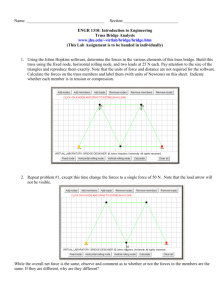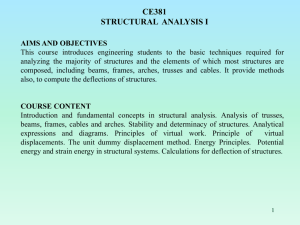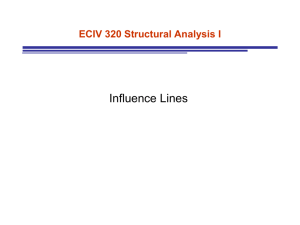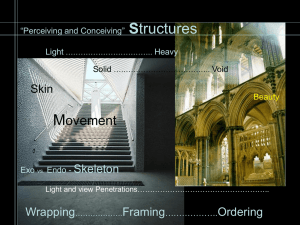FUTURA * Structures 7 wonders presentations
advertisement
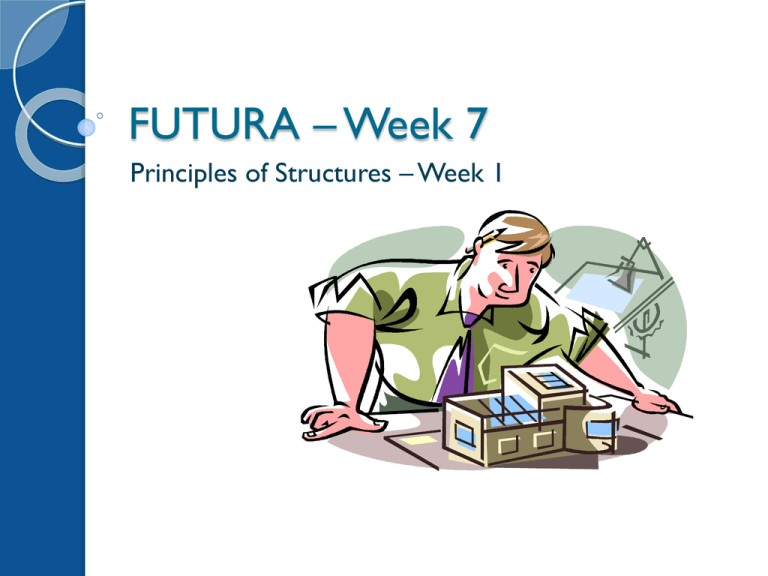
FUTURA – Week 7 Principles of Structures – Week 1 Agenda Renzulli: Building Big due 10/27 Donations: ◦ ◦ ◦ ◦ ◦ Straws – non flexible and LOTS! Newspaper – TONS! Paper Towel Tubes Shoeboxes Mini Marshmallows Principles of Structures Bill Nye: Structures Brain Pop - Building Basics Building Big - The Interactive Labs Basic Vocabulary of Structural Principles Weight Support Load Span Thrust Stress Tension Compression Gravity The pull of the earth that makes objects feel heavy; most easily felt as a downward force. Newton's Laws of Motion Forces Brain Pop – Force You Tube - Structures & Forces Tension – Stretching: lengthens the material Compression – Squeezing: shortens the material Torque - Twisting Shear - sliding Center of Mass Stability Channeling Loads Dead Loads Live Loads Dynamic Loads Wind Loads Earthquake Loads Thermal Loads Settlement Loads You Tube - Wind Loads on Structures Materials Elasticity ◦ a material whose change in shape vanishes rapidly when the loads on it disappear (rubber band) Plasticity – able to be easily shaped or molded Safety Factors Steel ◦ Pound per pound, steel is the material with the greatest strength obtainable at the lowest price. ◦ An alloy of iron and carbon ◦ Stainless Steel: add nickle ◦ Wrought Iron: less carbon (workable at low temperature) ◦ Cast Iron: high carbon (easily melted, cast into shapes) Reinforced Concrete ◦ Possibly the most interesting man-made structural material ◦ Formed into any shape, economical, available, fire resistant, Plastics ◦ Practically indestructible ◦ Fiberglas: reinforced with glass fibers making it shatterproof, strong in tension Column A vertical (upright) support member. Arch A true arch is a curving structure that can span an opening in a wall. It is made from wedge-shaped pieces that lean against each other (in compression). The central piece is often larger than the others. It is called the keystone, and it is the last piece to be put into place. Post & Lintel Some of the earliest builders used the postand-lintel principle of construction to span openings in a wall (doors and windows). Before the invention of the arch, they used two vertical beams (posts) to support the horizontal beam (lintel). Vault - Tunnel A vault - is a tunnel in the shape of a half circle. Many animals burrow tunnels underground. Dome A three dimensional form based on a circle. A dome may be half a sphere, but can take many other shapes. A dome is a series of equal arches that span the circle and meet in the center. These arches are called the ribs, just like the bones in your chest cavity that support your upper body, give shape to your torsos, and protect your lungs. The top of a dome is in compression, and gets stronger under a load because the ribs are pressed against each other. The bottom of the dome is in tension, because the ribs want to push away from each other. The bottom ring will prevent this. An egg shell is two domes put together. Egg shells are suprisingly strong. Column & Beam A beam is a horizontal structural member supported by one, two, or more columns. It is part of the skeleton of a building. Cantilever A beam that is only supported at one end. Buttresses A buttress is a thickening in a wall to make it stronger, or small outside walls at right angles acting to counteract the outward thrust of a heavy roof or wall. A flying buttress is a buttress with the non-structural part removed, giving a feeling of lightness. Gothic cathedrals relied heavily on flying buttresses. Tension & Compression Triangulation & Truss A truss is a system of support members that are held rigid (will not tend to collapse with the edition of a load). Trusses tend to be a series of triangles and can be found in bridges, pylons for electrical cables, or the Eiffel Tower. Acting out Structures Column Arch Post & Lintel Vault-Tunnel Dome Column & Beam Cantilever Flying Buttresses Load & Support Tension Compression DESIGN PROCESS IF AT FIRST… …you don’t succeed, try, try again. This saying is at the heart of the design process. Testing a design and then revising it based on what you’ve learned is an important key to success. Design Process When engineers solve a problem, their first solution is rarely their best. Instead, they try different ideas, learn from their mistakes, and try again. The series of steps engineers use to arrive at a solution is called the design process. This is when your background knowledge, along with creativity and originality come into play. Design Process - Brainstorm At this state, all ideas are welcome, and criticism is not allowed. How creative can you be? What specific goal are you trying to achieve, and how will you know if you have been successful? What are some ways you can start tackling today’s challenge? Design Process - Designing Time to get realistic. Talk through the brainstormed ideas. What’s really possible given your time, tools, and materials? It’s not cheating to look at other kids’ projects. What can you learn by looking at them? Design Process – Building, testing, evaluating, and revising Does your design meet the criteria for success? What is the hardest problem to solve as you build your project? Why do you have to do something a few times before it works the way you want? Design Process – Sharing solutions What do you think is the best feature of your design? Why? What are some things everyone’s designs have in common? What would you do differently if you had more time? What were the different steps you had to do to get your project to work the way you wanted? Logic – Teambuilding Collaborating – list to all ideas and contribute ideas of your own Critical Thinking – analyze the situation carefully Problem Solving – work through the design process toward a solution…you may fail along the way and that is ok Creative Thinking – think of new ideas based on what you know Communication – verbal with your group and written on your planning sheet Time Management – focus, stay on task, commitment Self Assessing – you will assess yourself and your group at the end. Paper Table Challenge Paper Table Challenge Teacher will put you into groups of 2 or 3 DO NOT rush to the next step of the design process…take your time and THINK! Identify the Problem Design and build a table out of newspaper tubes. Make it at least 8 inches tall and strong enough to hold a heavy book. Materials ◦ 1 piece of cardboard (approximately 8.5 x 11 in) ◦ Heavy book (dictionary) ◦ Masking tape ◦ 8 Sheets of newspaper Brainstorm & Design Look at materials and think about the questions below. Then sketch your ideas on a piece of paper. 1. How can you make a strong tube out of a piece of paper? 2. How can you arrange the tubes to make a strong, stable table? 3. How can you support the table legs to keep them from tilting or twisting? 4. How level and big does the table’s top need to be to support a heavy book? Build, Test, Evaluate, & Redesign Use the materials to build your table. Then test it by carefully setting a heavy book on it. When you test, your design may not work as planned. If things don’t work out, it’s an opportunity-not a mistake! When engineers solve a problem, they try different ideas, learn from mistakes, and try again. Study the problems and then redesign. Build, Test, Evaluate, & Redesign For example, if: ◦ The tubes start to unroll – re-roll them so they are tighter. A tube shape lets the load (i.e. the book) push on every part of the paper, not just one section of it. Whether they’re building tables, buildings, or bridges, load distribution is a feature engineers think carefully about. ◦ The legs tilt or twist – Find a way to stabilize and support them. Also check if the table is lopsided, too high, or has legs that are damaged or not well braced. ◦ A tube buckles when you add weight – Support or reinforce the weak area, use a wider or thicker walled tube, or replace the tube if it’s badly damaged. Changing the shape of a material affects its strength. Shapes that spread a load well are strong. Dents, creases, and wrinkles that put stress on some areas more than others make a material weaker. ◦ The table collapses – Make its base as sturdy as possible. Also, a table with a lot of triangular supports tends to be quite strong. A truss is a large, strong support beam. It is built from short boards or metal rods that are arranged as a series of triangles. Engineers often use trusses in bridges, buildings, and towers. Design Process – Sharing solutions What do you think is the best feature of your design? Why? What are some things everyone’s designs have in common? What would you do differently if you had more time? What were the different steps you had to do to get your project to work the way you wanted? Centers Level Contract: Complete all activities in that level first Activities ◦ Thinker Problem Solve Think Critically Be Creative Research: use Renzulli or Online Databases (safety) and log resources! ◦ Worker Pursue Challenge Manage Time Produce Quality Work Reflection Assessment ◦ Reflector Self-Assessing Product and Performance
